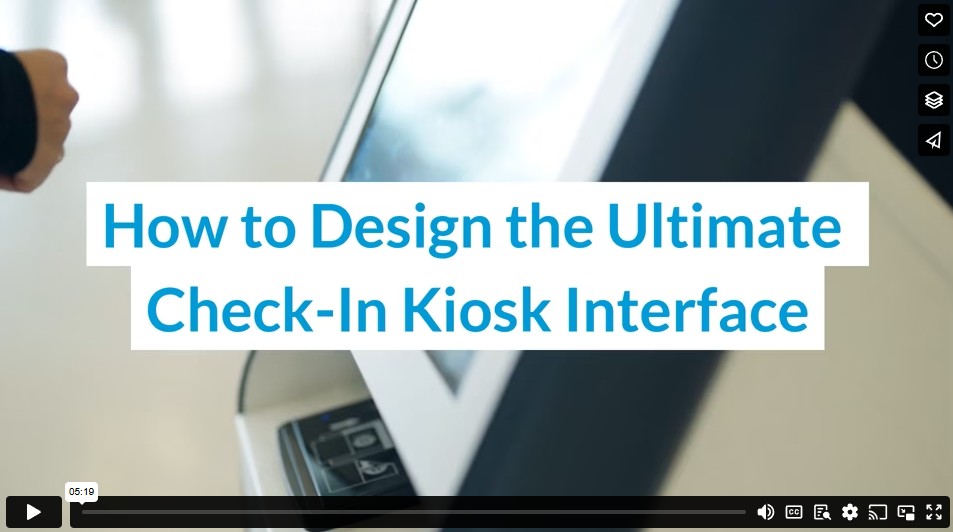Excellent event planning is all about anticipation—predicting what guests will want and need before they even have to ask. From the moment they register for your event to the moment they leave, every interaction should feel welcoming.
That same principle applies to your check-in kiosks. A well-designed interface doesn’t just robotically process guests; it understands them. It anticipates their needs and guides them naturally with clear navigation, intuitive layouts, and accessible features that work for everyone.
Creating an ideal user interface for your check-in kiosks might seem daunting, but it doesn’t have to be. With enough research and understanding of your guests, you can design an event check-in kiosk experience that perfectly blends creativity with functionality, ensuring your guests feel at ease from the very first tap.
Why Design Your Check-In Interface?
You might wonder whether your check-in process is really that important. After all, if you do it right, your guests should finish the process in just a few minutes. Is it really that crucial to carve out valuable planning time just for a few minutes of the guest experience?
The answer is absolutely. Your check-in area is the first impression guests will have of your event. If you don’t do it right, you’ll leave a sour taste that guests will carry with them throughout the event—no matter how much you try to make up for it in other ways.
Additionally, designing a functional and attractive check-in interface is about more than just giving your guests a good time. Providing accessibility accommodations is critical to ensure everyone can easily and successfully navigate your event from start to finish.
Creating the Ideal Check-in Kiosk Interface
Now that you understand the importance of designing an ideal check-in process, it’s time to focus on the design itself.
Step 1: Research
Planning an event is all about researching your target audience. Without proper research, you could end up with an event that doesn’t resonate with your guests in any way. A poorly researched event leads to unhappy guests, negative survey responses, and few return attendees.
Designing your check-in process is no different. Look at your guests’ preferences, demographics, and especially their typical technology proficiency to gauge the kind of interface they’ll need. Those who work in tech can probably zip through the process in seconds and understand most jargon, but seniors and retired citizens might need a little more guidance.
Speaking of jargon, if there’s any specialized phrasing in your check-in interface, make sure every one of your guests will understand its meaning. If there’s even a chance that some might not understand, it’s best to rephrase or remove it altogether.
Step 2: Determine the Physical Kiosk Situation
Software design is one thing, but you’ll also need to consider your physical kiosks. Does your software provider supply kiosks for your use, or will you need to provide your own for guests?
Determining your situation relatively early in the process is important because it will help you with some of the design aspects of your interface (more on that later).
Step 3: Design a Simple but Intuitive Interface
The way you design your check-in system will vary depending on the results of your guest research. In general, you want to aim for a clean, minimalist design that offers clear instructions, simplified options, and easy navigation.
However, keep in mind that “minimalist” doesn’t mean sterile or bare. You want to keep the process easy for your guests, but making it attractive is also vital for the guest experience. Add colors that match your logo or your software provider’s. Legible but aesthetically pleasing fonts are also essential. Even simple animations (like buttons that change color or fade after attendees select a choice) can improve the experience.
Step 4: Consider Accessible Options
Your guests will likely come from a wide range of backgrounds, including many who may require accommodations. These could be anything from wheelchair ramps and lowered kiosks to alternate check-in options for those with hearing or vision impairments.
Here are some critical aspects to keep in mind when designing your check-in process:
- Ensure fonts are legible, buttons are large, and everything is well-spaced
- Provide adequate color contrast between foreground and background items
- Integrate multiple languages and design each one individually for clarity and aesthetics
- Offer alternative options, such as audio guides or an employee to complete the process, for anyone who cannot use kiosks
- Ensure all kiosks are at a height that everyone, even very short people, can reach
Making the check-in process as comfortable and inclusive as possible will help everyone feel welcomed. This will start your event on the right track and give you a much higher chance of success.
Step 5: Listen, Learn, and Adapt
Gathering guests’ opinions and using them to improve your next event is imperative. You may think you’ve planned the perfect check-in process, but without your attendees’ feedback, how can you know for sure?
In addition to sending post-event surveys to all guests, placing feedback kiosks throughout your event can give you valuable responses to upgrade your check-in process and give your guests an even better first impression.
Perfecting the First Impression with Check-In Kiosks
With so much involved in event planning, it can be tempting to quickly build your check-in interface and move on to another important step. However, skipping over this process too quickly can be detrimental to your guests’ first impression of your event.
By blending simplicity with style and accounting for accessibility options, your conference check-in software can help you build a check-in interface that sets the perfect tone for your event and helps every guest feel welcomed and excited for all that’s to come.
Video

Infographic
Creating a user-friendly interface for check-in kiosks can be straightforward with thorough research and a clear understanding of your guests’ needs. Explore this infographic for valuable tips on designing the perfect check-in kiosk interface.

